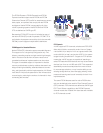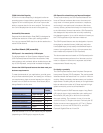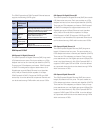
FICON Link Incident Reporting
FICON Link Incident Reporting is designed to allow an
operating system image (without operating intervention) to
register for link incident reports, which can improve the
ability to capture data for link error analysis. The informa-
tion can be displayed and is saved in the system log.
Serviceability Enhancements
Requests Node Identifi cation Data (RNID) is designed to
facilitate the resolution of fi ber optic cabling problems.
You can now request RNID data for a device attached to a
native FICON channel.
Local Area Network (LAN) connectivity
OSA-Express3 – the newest family of LAN adapters
The third generation of Open Systems Adapter-Express
(OSA-Express3) features have been introduced to help
reduce latency and overhead, deliver double the port den-
sity of OSA-Express2, and provide increased throughput
Choose the OSA-Express3 features that best meet your
business requirements.
To meet the demands of your applications, provide granu-
larity, facilitate redundant paths, and satisfy your infrastruc-
ture requirements, there are seven features from which to
choose. In the 10 GbE environment, Short Reach (SR) is
being offered for the fi rst time.
Feature Infrastructure Ports per
Feature
OSA-Express3 GbE LX
Single mode fi ber
4
OSA-Express3 10 GbE LR
Single mode fi ber
2
OSA-Express3 GbE SX Multimode fi ber 4
OSA-Express3 10 GbE SR Multimode fi ber 2
OSA-Express3-2P GbE SX Multimode fi ber 2
OSA-Express3 1000BASE-T Copper 4
OSA-Express3-2P 1000BASE-T Copper 2
Note that software PTFs or a new release may be required
(depending on CHPID type) to support all ports.
OSA-Express3 for reduced latency and improved throughput
To help reduce latency, the OSA-Express3 features now
have an Ethernet hardware data router; what was previ-
ously done in fi rmware (packet construction, inspection,
and routing) is now performed in hardware. With direct
memory access, packets fl ow directly from host memory
to the LAN without fi rmware intervention. OSA-Express3 is
also designed to help reduce the round-trip networking
time between systems. Up to a 45% reduction in latency at
the TCP/IP application layer has been measured.
The OSA-Express3 features are also designed to improve
throughput for standard frames (1492 byte) and jumbo
frames (8992 byte) to help satisfy the bandwidth require-
ments of your applications. Up to a 4x improvement has
been measured (compared to OSA-Express2).
The above statements are based on OSA-Express3 perfor-
mance measurements performed in a laboratory environ-
ment on a System z10 and do not represent actual fi eld
measurements. Results may vary.
Port density or granularity
The OSA-Express3 features have Peripheral Component
Interconnect Express (PCI-E) adapters. The previous table
identifi es whether the feature has 2 or 4 ports for LAN con-
nectivity. Select the density that best meets your business
requirements. Doubling the port density on a single feature
helps to reduce the number of I/O slots required for high-
speed connectivity to the Local Area Network.
The OSA-Express3 10 GbE features support Long Reach
(LR) using 9 micron single mode fi ber optic cabling and
Short Reach (SR) using 50 or 62.5 micron multimode
fi ber optic cabling. The connector is new; it is now the
small form factor, LC Duplex connector. Previously the SC
Duplex connector was supported for LR. The LC Duplex
connector is common with FICON, ISC-3, and OSA-
Express2 Gigabit Ethernet LX and SX.
25


















